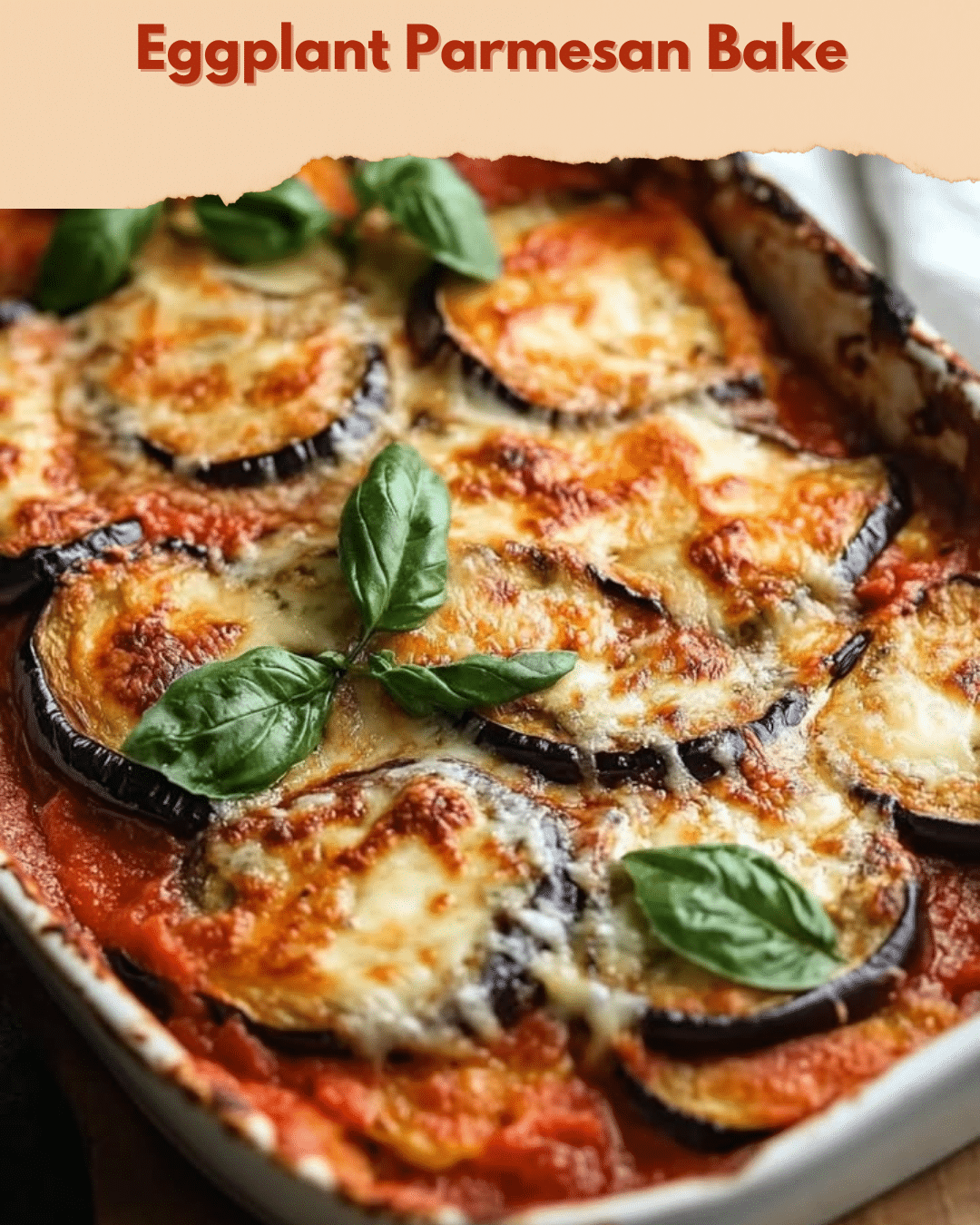Eggplant Parmesan: A Classic Italian Delight
Eggplant Parmesan is an iconic Italian dish that brings together the delights of crispy, layered eggplant with rich tomato sauce and melted cheese. Its savory flavors make it a favorite comfort food for many, offering the perfect harmony of textures and tastes. Whether you are an experienced cook or a kitchen novice, making Eggplant Parmesan from scratch is a rewarding experience that will leave your taste buds singing.
Quick Recipe Highlights
- Flavor Profile: Eggplant Parmesan is a symphony of deliciously rich tomato sauce, the subtle bitterness of fried eggplant, and the creamy, slightly salty notes of Parmesan and mozzarella cheese.
- Texture: Enjoy a delightful layered texture of crispy fried eggplant, smooth tomato sauce, and melted cheese creating a delightful chewiness with every bite.
- Aroma: The combination of fresh basil, garlic, and rich tomato sauce evokes a classic Italian kitchen fragrance.
- Visual Appeal: The golden-brown crust of baked cheese provides a visually stunning contrast to the vibrant red sauce and eggplant layers.
- Skill Level Needed: While some knife skills for slicing eggplant and proficiency in layering the ingredients are beneficial, this recipe is approachable for home cooks eager to explore Italian cuisine.
- Special Equipment: A sturdy baking dish is essential in ensuring even cooking and a visually appealing presentation.
Recipe Overview
- Difficulty Level: Eggplant Parmesan is moderately challenging. It involves several steps, including preparing and frying eggplant, making a tomato sauce, and then assembling and baking the dish. A good recipe to bridge beginner and intermediate cooking skills.
- Category: This savory delight fits into both main dish and side dish categories, perfect for a hearty lunch or a satisfying dinner meal.
- Cuisine: A staple of Italian cooking, Eggplant Parmesan is rich in Mediterranean flavors, drawing on Italian culinary traditions.
- Cost: With eggplant and basic pantry items as primary ingredients, it’s a cost-effective dish, allowing for gourmet flavors without a hefty price tag.
- Season: Best enjoyed year-round, though particularly in the late summer and fall when eggplants are at peak freshness and flavor.
- Occasion: Ideal for family dinners, gatherings, or any occasion where comfort food is on the menu, offering a rustic yet elegant dining experience.
Why You’ll Love This Recipe
Eggplant Parmesan is the perfect blend of savory, cheesy, and slightly tangy flavors thanks to its rich tomato base. Each bite offers a contrast of crispy and creamy textures, bringing a true Italian flavor profile to your home kitchen. Moreover, it is a dish that provides fantastic leftovers; the flavors meld beautifully, making it arguably more delicious the day after cooking.
This recipe is a wonderful opportunity for home cooks to appreciate the art of Italian cooking. The preparation process, although detailed, is straightforward and provides a great sense of accomplishment once layered and baked to perfection. It’s an opportunity to hone your culinary skills in a rewarding way.
Nutritionally, eggplants are a great source of fiber, vitamins, and antioxidants. This makes Eggplant Parmesan not just a tasty treat but also a dish rich in nutrients. Pair it with a simple salad for a balanced meal.
For social gatherings, Eggplant Parmesan offers a vegetarian-friendly option that can satisfy even the most dedicated meat-lovers. Its universally appealing flavors and the rustic elegance of its presentation make it a dining table star.
When it comes to cost, Eggplant Parmesan certainly offers value for money. Accessible ingredients such as eggplant, tomatoes, and cheese mean you can create a gourmet dish without breaking the bank. It’s a standout, budget-friendly crowd-pleaser.
Historical Background and Cultural Significance
Eggplant Parmesan, known traditionally as “Parmigiana di Melanzane” in Italy, has deep roots in Southern Italian cuisine, particularly in regions like Sicily and Campania. The origin story reflects the simplicity and ingenuity of Italian cooking, where humble ingredients are transformed into a decadent dish.
Culturally, it’s considered a classic Italian comfort food, often appearing at family gatherings and special occasions. Its preparation varies slightly from family to family, and each variation tells a story of regional influences and personal preferences.
Historically, eggplants were introduced to Italy from the Middle East, and their integration into Italian cuisine marks a fascinating culinary evolution. Over time, this dish traveled beyond Italy, gaining admiration and adaptation in different cultures worldwide.
Regional variations are plentiful, with some using alternative cheeses or adding other vegetables. What remains constant is the beloved combination of textures and flavors that make Eggplant Parmesan a cherished culinary masterpiece.
Ingredient Deep Dive
Eggplant is the star of Eggplant Parmesan, often praised for its versatility and ability to absorb flavors. Selecting a fresh, firm eggplant with glossy skin ensures you get the best out of your dish. Nutritionally, eggplants are low in calories and provide a good amount of fiber and potassium, promoting good heart health.
Tomatoes form the base of the sauce, contributing to the comforting and addictive flavor. Opt for ripe, flavorful tomatoes or a high-quality canned variety for convenience. They add a rich supply of antioxidants, particularly lycopene, which is known for its health benefits.
Parmesan and mozzarella cheeses contribute to the signature creamy, salty richness. Using authentic Italian Parmesan, if possible, elevates the dish. They offer calcium and protein while adding to the memorable flavor profile of this classic recipe.
Fresh basil offers the perfect aromatic finish, giving the Eggplant Parmesan its unmistakable Italian identity. Basil leaves are rich in essential oils that give them their delicious aroma and also offer some anti-inflammatory properties.
Common Mistakes to Avoid
- Choosing overripe or under-ripe eggplants can affect the dish’s texture and flavor. Look for firm, unblemished skin.
- Not salting the eggplant before frying can result in a soggy texture. Salting draws out excess moisture.
- Using too much oil when frying can make the dish greasy. Use a non-stick pan and drain excess oil.
- Not allowing the tomato sauce to simmer long enough can lead to a thin sauce lacking in depth.
- Skipping the prebaking step for eggplant can result in undercooked layers and affect the dish’s integrity.
- Overfilling the baking dish may lead to spillage and uneven cooking.
- Using pre-grated or low-quality cheese may result in a grainy texture. Freshly grated cheese offers superior meltability and taste.
- Not resting the baked dish before cutting can lead to messy serving. Allow it to cool slightly for easier portioning.
Essential Techniques
Mastering the art of layering is crucial for a successful Eggplant Parmesan. Ensure each layer is evenly distributed, with balanced amounts of tomato sauce and cheese for a harmonious taste.
Frying the eggplant correctly is vital. Achieve a golden-brown texture without excess oil absorption by using the right amount of heat and patience.
The sauce must be simmered to concentrate its flavors. Well-reduced tomato sauce provides the foundation for vibrant taste and prevents the dish from being watery.
Baking evenly is key; ensure your oven is preheated and use the middle rack for consistent heat.
Choosing the right bakeware size matters, as using too large or small a dish can affect the cooking time and final presentation.
Pro Tips for Perfect Eggplant Parmesan
Pre-salt and sweat the eggplant slices to draw out bitterness and excess moisture for the ideal crisp texture.
Use homemade or high-quality tomato sauce for that rich, savory base essential to a classic Eggplant Parmesan.
Grate your Parmesan cheese for better meltability and richer flavor compared to store-bought shredded cheese options.
Layer thoughtfully. Balance is key; each layer should have an even amount of ingredients to ensure consistent taste throughout.
Cover with aluminum foil for the first half of baking to prevent the cheese from burning and remove it halfway through for a perfectly golden top.
Let the dish rest after baking to allow the layers to set, making it easier to serve neat slices.
Experiment with different herbs like thyme or oregano, either in the sauce or as a garnish, to enhance the traditional flavors.
Variations and Adaptations
For a regional variation, try adding a layer of thinly sliced zucchini or bell peppers, adding both flavor and a dash of color.
Summer offers the perfect opportunity to incorporate fresh seasonal vegetables, such as using grilled eggplants for a smoky twist.
Make a low-carb version by eliminating the breadcrumbs and focusing on hearty layers of eggplant and cheese.
Customize the flavors by incorporating different cheeses, like ricotta or provolone, for a unique twist on the classic.
For those who prefer a different texture, try lightly coating the eggplant slices in cornstarch for a crispier result.
Present Eggplant Parmesan in individual ramekins for a modern twist and personalized dining experience.
Serving and Presentation Guide
Serve Eggplant Parmesan hot, allowing the melted cheese to shine as the centerpiece of the dish.
Consider garnishing with fresh herbs, like basil or parsley, for a pop of color and an aromatic finish.
Traditional accompaniments include a fresh garden salad or crusty garlic bread, perfect for soaking up the rich sauce.
For a modern serving suggestion, host a family-style dinner where the dish is the star alongside an antipasto platter.
Ensure it’s hot enough but not piping when serving, which allows flavors to be at their best while avoiding burned palates.
Portion control can be maintained by using a sharp knife to cut even slices, ensuring each serving is uniform and satisfying.
Wine and Beverage Pairing
A robust red wine such as Chianti complements the rich tomato flavors and savory cheese notes, enhancing the dining experience.
For non-alcoholic alternatives, consider pairing with a rich grape juice or a pomegranate spritzer, balancing the dish’s flavors.
If hosting a brunch featuring Eggplant Parmesan, iced teas flavored with citrus or herbs offer a light yet flavorful contrast.
Serving wine and beverages at the appropriate temperature, reds slightly chilled and whites well-cooled, ensures the best flavor profile.
Consider small servings of Italian Aperol Spritz for a bubbly, citrusy refreshment that cuts through the richness delightfully.
Storage and Shelf Life
Store leftovers in an airtight container, either in the fridge for up to 3 days or freeze for longer-lasting preservation.
Ensure the dish is fully cooled before storing to prevent condensation and prolong freshness.
Use glass containers for storage, where possible, to avoid flavor transfer and maintain taste quality.
Signs of spoilage include an off smell, discoloration, or mold; be vigilant during reheating.
To reheat, cover with foil and bake in a preheated oven to restore moisture and prevent drying out.
Freezing guidelines suggest properly sealing portions to prevent freezer burn and maintain texture.
Make Ahead Strategies
Prepare the sauce in advance, storing it up to a week ahead in the refrigerator, saving valuable prep time.
Store breaded or baked eggplant slices separately; assemble just before final baking for optimal freshness.
Evaluate quality impact by gradually incorporating prepared elements, maintaining balance of flavor.
Reheat thoroughly in the oven rather than the microwave for even warming and best texture.
Add fresh garnishes like basil right before serving for a vibrant and aromatic touch.
Scaling Instructions
Halve the recipe easily by maintaining the same layering technique, reducing stock ingredients proportionally.
When doubling, consider using two baking dishes for even cooking spread across larger portions.
Adapting equipment size (larger baking trays) ensures consistency across batches and prevents overcrowding.
Timing modifications may require increased preparation for larger volumes, especially for eggplant frying.
Assess storage considerations if making larger quantities, with ample space for prep and cooling.
Nutritional Deep Dive
Eggplant Parmesan is nutrient-dense, providing essential macronutrients like carbohydrates from eggplant and cheese proteins.
Micronutrient analysis reveals a high vitamin C content from tomatoes, promoting immune health as well as antioxidants to enhance vitality.
The inclusion of ‘good’ fats from cheese balances the macro profile, aiding satiety and enjoyment.
Dietary considerations include ensuring lactose-intolerance friendly options, such as lactose-free cheese.
Focus on sensible portions to savor flavors without overindulgence.
Weight management tips prioritize pairing with greens or light salads to optimize the meal’s nutritional value.
Dietary Adaptations
Gluten-free alternatives, such as almond flour, can replace traditional breadcrumbs for those with gluten sensitivities.
Substituting dairy cheeses with plant-based options ensures dairy-free accommodating without losing essence.
For the vegan variant, explore using nutritional yeast for cheese flavor and plant-based proteins for nutritional balance.
For low-carb diets, consider layering eggplant with protein-packed layers instead of traditional breadcrumbs.
Keto adherents may appreciate increased healthy fat additions, using oils like avocado for frying.
Paleolithic preferences can be maintained with natural, minimally processed ingredients, honoring ancestral diet principles.
Low-FODMAP guidelines suggest adjusting garlic and onion content for enhanced digestive comfort.
Other specific diets, including low-sodium, may require adjustments, such as reduced cheese or alternative seasonings.
Troubleshooting Guide
To address texture issues, ensure no excess moisture in eggplant; salt and pat dry for ideal consistency.
Achieving balanced flavor involves using quality, fresh ingredients and carefully monitoring salt and herb proportions.
Temperature problems can arise if ovens aren’t preheated; verify with an oven thermometer for accuracy.
Incorporate equipment challenges by utilizing non-stick or heavy-duty baking trays whenever possible.
Adapt ingredient substitutions by maintaining foundational flavors, such as cheese, with alternative flavor profiles.
Timing concerns can be managed through pre-cooked components, ensuring readiness for gradual step integration.
Recipe Success Stories
Community feedback highlights the joyous tradition of making and sharing Eggplant Parmesan across generations.
Variation successes include adding fresh tomatoes to enrich the sauce or trying new cheese blends for different tastes.
Adaptation stories celebrate individual preferences—like using less oil for a lighter version—while preserving classic charm.
Reader suggestions inspire thoughtful improvements like reducing the salt for those pursuing a healthier lifestyle.
Photography tips feature perfect dishes arranged under natural lighting, capturing the golden freshness of the cheese and vibrant eggplant.
Frequently Asked Questions
A: Yes, Eggplant Parmesan is great for meal prep. Prepare the sauce and partially bake the eggplant, storing separately until needed for final assembly and baking.
Q: What is the best way to reheat Eggplant Parmesan?
A: Reheat by covering with foil in a preheated oven at 350°F for 20 minutes until warmed through. Avoid microwaving to preserve texture.
Q: Can I substitute another vegetable for eggplant?
A: Zucchini and squash are viable alternatives. Ensure proper slice thickness and don’t skip salting or pre-baking steps.
Q: Are there vegan options for Eggplant Parmesan?
A: Absolutely, use plant-based cheese alternatives and nutritional yeast for the cheese flavors; incorporate vegetable-based proteins.
Q: Is it possible to make it without frying the eggplant?
A: Yes, bake or grill the slices instead for a healthier option, using parchment paper to prevent sticking.
Q: How do I make gluten-free Eggplant Parmesan?
A: Simply replace breadcrumbs with almond flour or gluten-free alternatives to meet dietary needs while enjoying classic flavors.
Q: Can I freeze Eggplant Parmesan?
A: It freezes well post-assembly but before baking; ensure proper wrapping to avoid freezer burn and thaw fully before baking.
Q: What should I do if my dish turns out watery?
A: Ensure that eggplants are well-salted and drained before cooking. Use a well-reduced tomato sauce for the right consistency.
Q: Are there any preferred cheese combinations?
A: Mozzarella and freshly grated Parmesan are classics, but adding provolone or asiago can enhance flavor complexity.
Q: Can I serve Eggplant Parmesan cold or at room temperature?
A: While best served warm, it can also be enjoyed at room temperature, offering a more robust flavor spectrum.
Additional Resources
Explore related recipes like Baked Ziti or Chicken Parmesan for variations on the savory Italian theme.
Dive into technique guides for mastering the art of frying, perfecting sauce simmering, and achieving bake balance.
Enhance your ingredient insights with seasonal vegetable guides and cheese selection tips for optimal pairing.
Leverage equipment recommendations aimed at achieving the perfect bake, including high-quality pans and ovens.
Seasonal variations offer opportunities for creative adaptation, bringing dynamic flavors to traditional favorites.
Print
Eggplant Parmesan Bake
Description
A deliciously baked eggplant dish layered with marinara sauce and cheese, perfect for a hearty family meal.
Ingredients
For the Crust:
- 2 medium eggplants, sliced
- 2 cups marinara sauce
- 2 cups shredded mozzarella cheese
Instructions
1. Prepare the Crust:
- Preheat the oven to 375°F (190°C).
- Layer the sliced eggplants in a baking dish, covering each layer with marinara sauce and mozzarella cheese.
- Bake in the preheated oven for 30 minutes or until the cheese is golden and bubbly.
Notes
You can customize the seasonings to taste.





